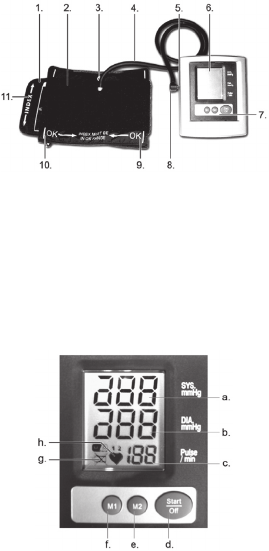
30 31
30 31
KEY TO MAIN COMPONENTS OF THE
APPLIANCE
1. Velcro strap
2. Cuff
3. Ø symbol
4. Air hose
5. Air hose hole
6. Display
7. Control buttons
8. Hose connector
9. <-OK mark
10. OK-> mark
11. INDEX mark
Display and control buttons
a. Systolic blood pressure
b. Diastolic blood pressure
c. Pulse
d. On/off button
e. M2 button (memory 2)
f. M1 button (memory 1)
g. Battery symbol
h. Pulse symbol
ABOUT BLOOD PRESSURE
What is blood pressure?
When the heart pumps blood around the
body, the blood exerts pressure on the
walls of the blood vessels. This is known
as blood pressure.
Blood pressure is different in different parts
of the body and depends on the pulse,
how elastic the blood vessels are and how
thick the blood is.
The pressure that can be measured when
the heart pumps out into the body is
known as systolic blood pressure. The
pressure that can be measured when blood
runs back from the body towards the heart
is known as diastolic blood pressure.
The two types of blood pressure are
usually given together, with the systolic
blood pressure always given rst. If blood
pressure is given as “120/70” (expressed
as “120 over 70”), this means that the
systolic blood pressure is 120, and the
diastolic 70.
The reading unit for blood pressure is
mmHg (millimetres of mercury).
Why does blood pressure vary?
Blood pressure varies throughout the day
and over a person’s life. Many different
factors affect your blood pressure,
something you should be aware of when
taking your blood pressure. For instance,
be aware of the following:
• Blood pressure is higher during the day
than at night.
• Blood pressure increases slightly after
you have just eaten. A lot of salt in food
can also increase blood pressure.
• Light exercise (e.g. walking and
jogging) causes the systolic blood
pressure to rise slightly, while
hard exercise will cause it to rise
dramatically. However, it will fall
again when the body relaxes. A lack
of exercise raises blood pressure
permanently.
• Blood pressure can increase if you are
excited, stressed or tense.
• Sudden climatic changes can cause
blood pressure to rise.


















